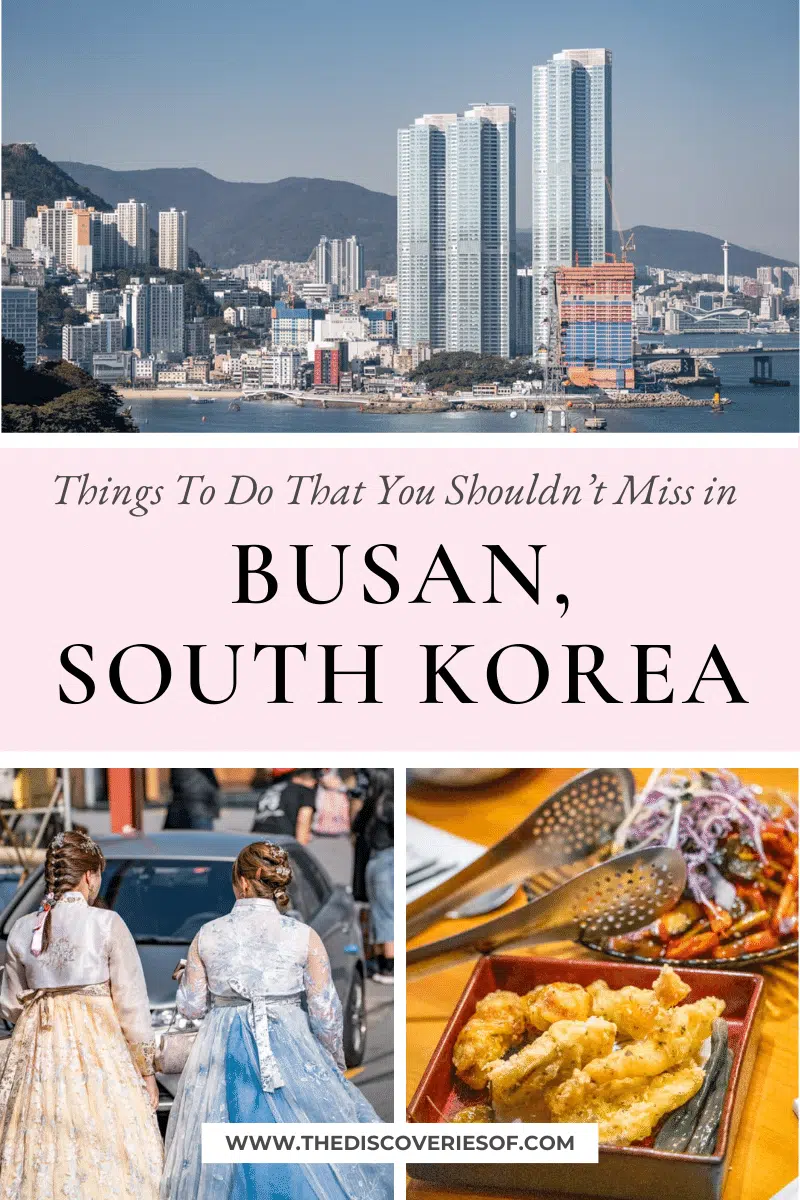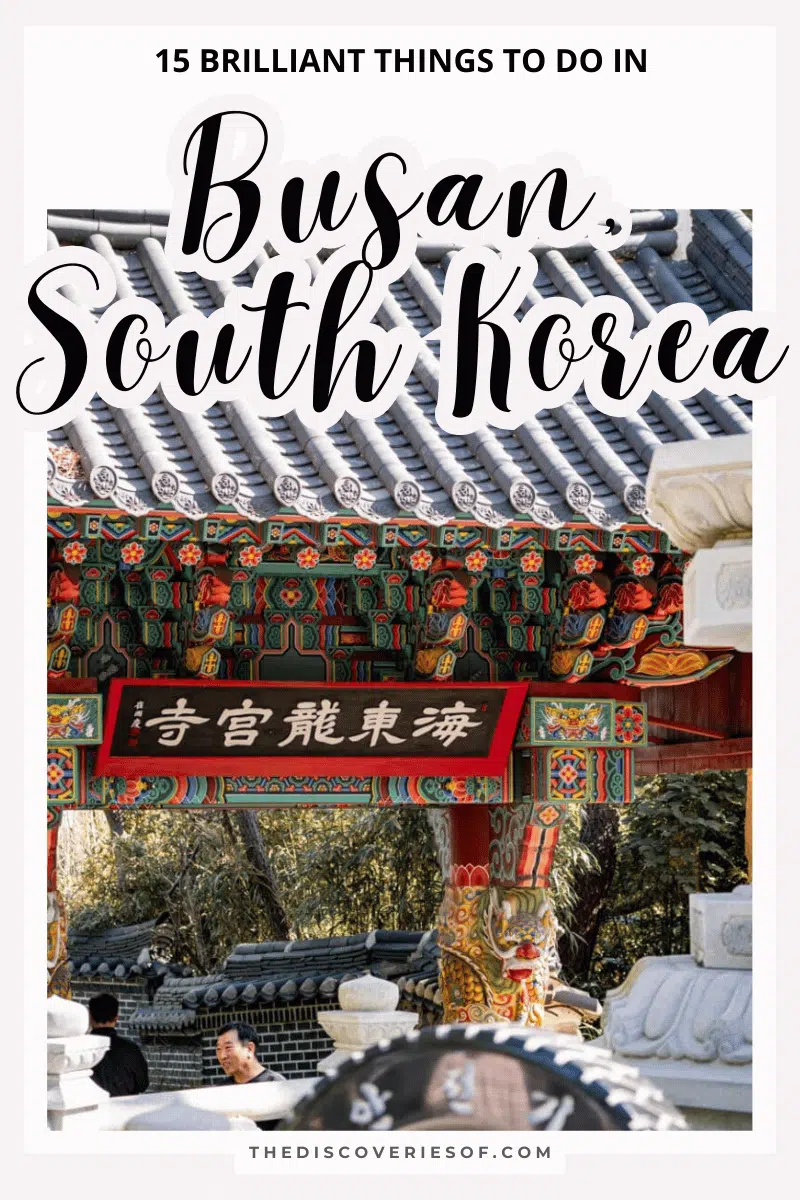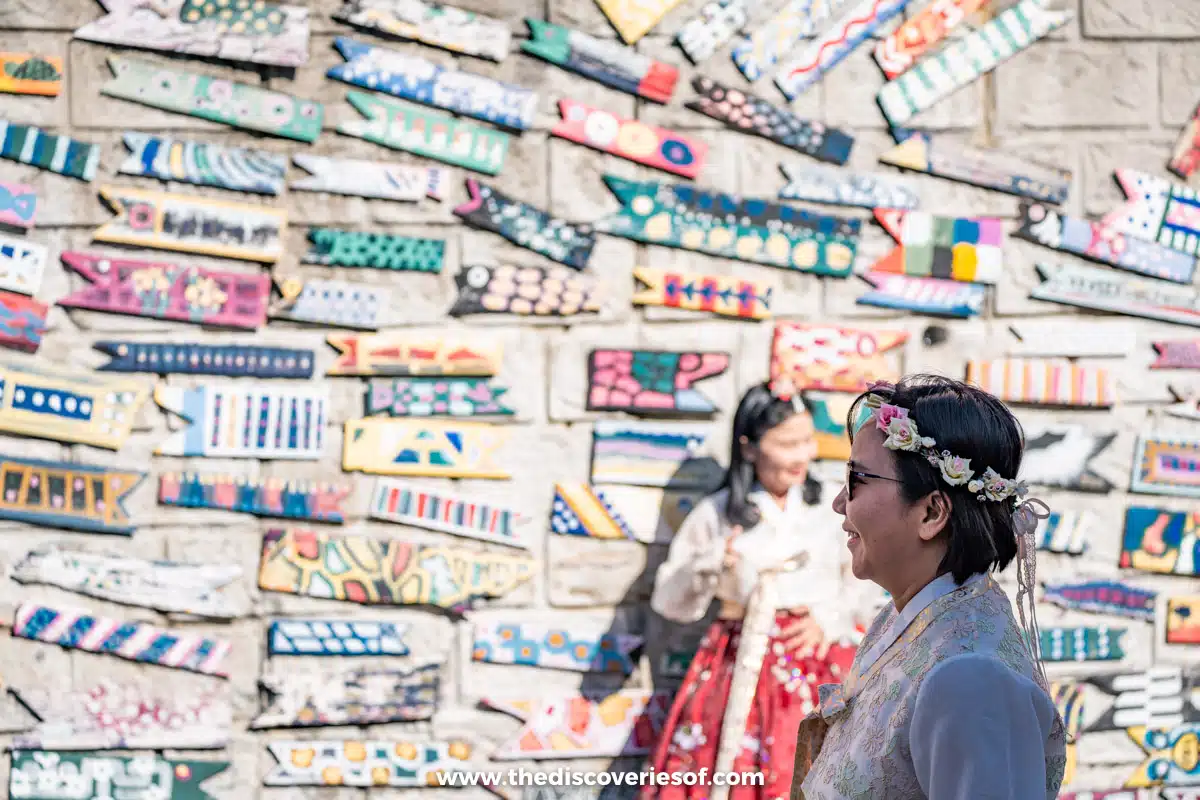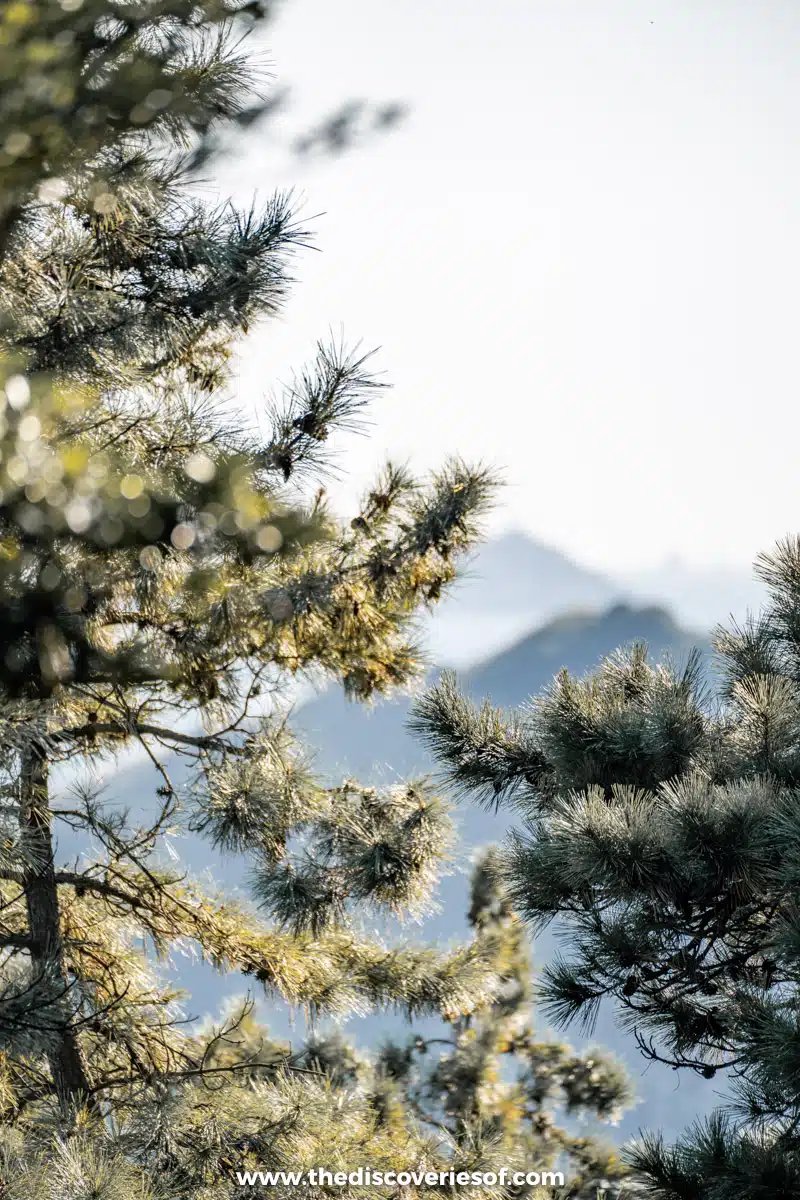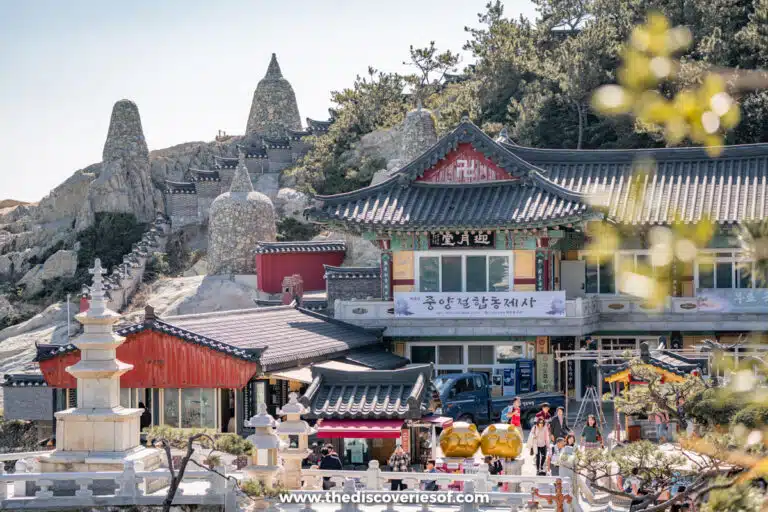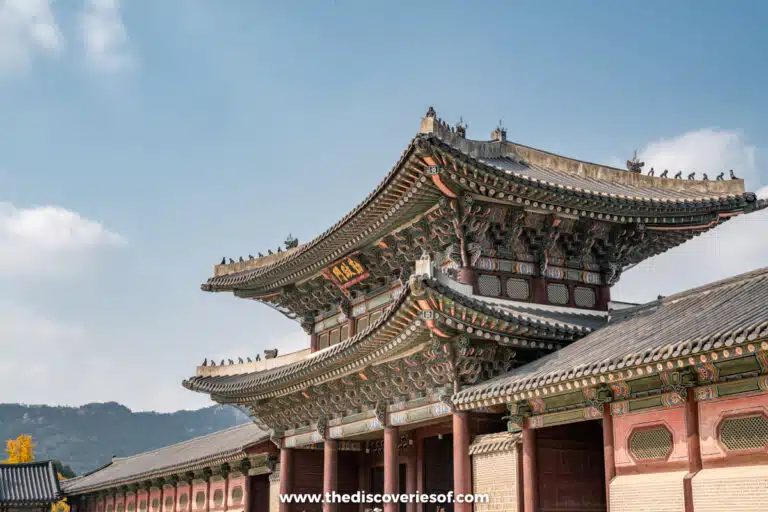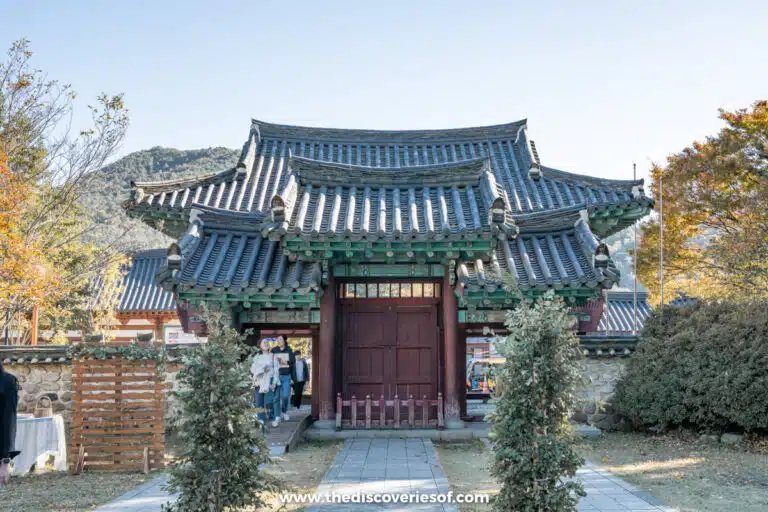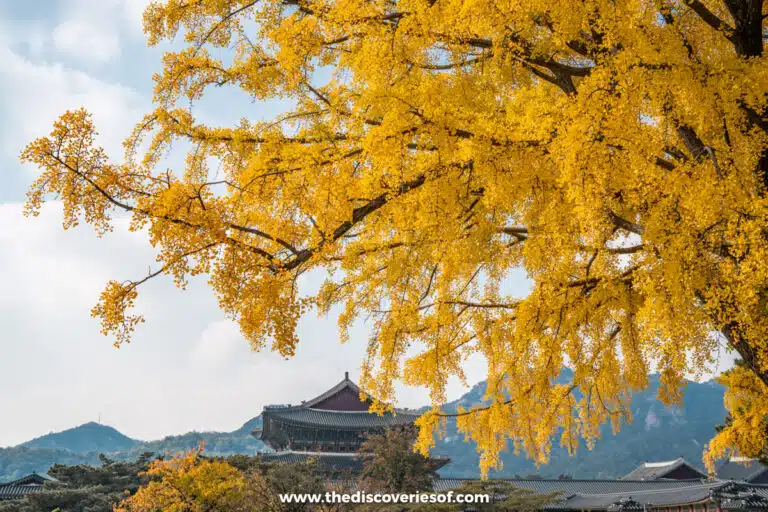Looking for the top things to do in Busan? Delve into the sights, adventures and epic eats you really shouldn’t miss during your trip.
Playing a second city isn’t always easy, but let me tell you, Busan has every bit of charm and excitement as any location in South Korea, including Seoul.
I have no qualms admitting the fact that I thought Busan would be your standard city destination, you know: a couple of big sights, a lot of busy people and a distinct dearth of charm.
Well peeps, I was wrong. Busan is an absolute charmer of a destination – one where you can go stand-up paddleboarding in the bay one moment, float above the water on a slick cable car the next… all followed up with some of the best food you can lay hands on in the country (and trust me, that’s high praise indeed).
Tempting as it is with its coastal location, you can’t just make Busan a beach trip. Important landmarks like the UN Memorial Cemetery and Gamcheon Cultural Village help give you some perspective on Korea’s rich and complicated history and how the past influenced what it is today.
All this before I even tell you about the best meal I had anywhere in South Korea.
Ready to plan your trip? Let’s uncover the top attractions and hidden gems in this guide to what to do in Busan.
Best Things to Do in Busan
Tour the UN Memorial Cemetery
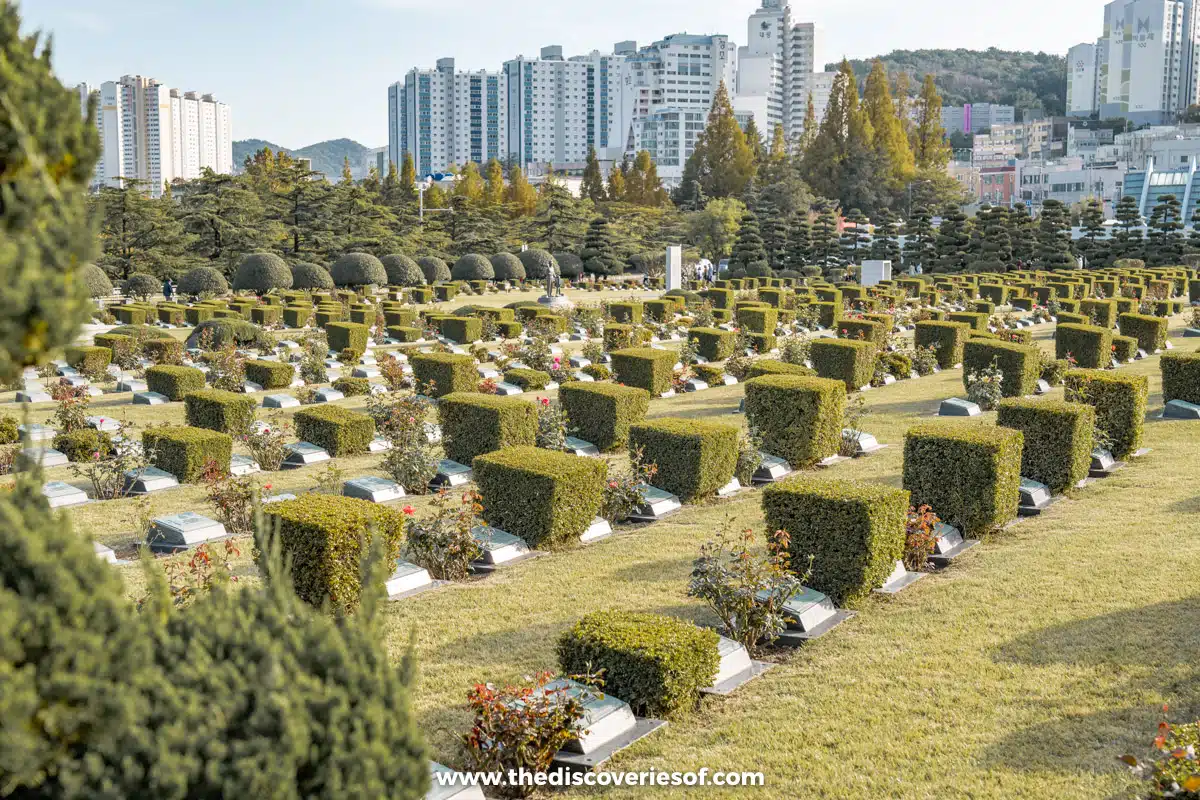
After WWII (in what’s an all too brief summary), the United States of America and the USSR forced Japan to end their 35-year occupation of Korea, and it became what we now know as North Korea and South Korea.
North Korea attempted to bring communist rule to South Korea in the summer of 1950, and the United Nations stepped in with the US and other allies to protect the Republic of Korea (South Korea).
Pusan (Busan) was the temporary seat of government for South Korea and an essential port for military supplies during the war, and the population tripled, with thousands of refugees moving into the city.
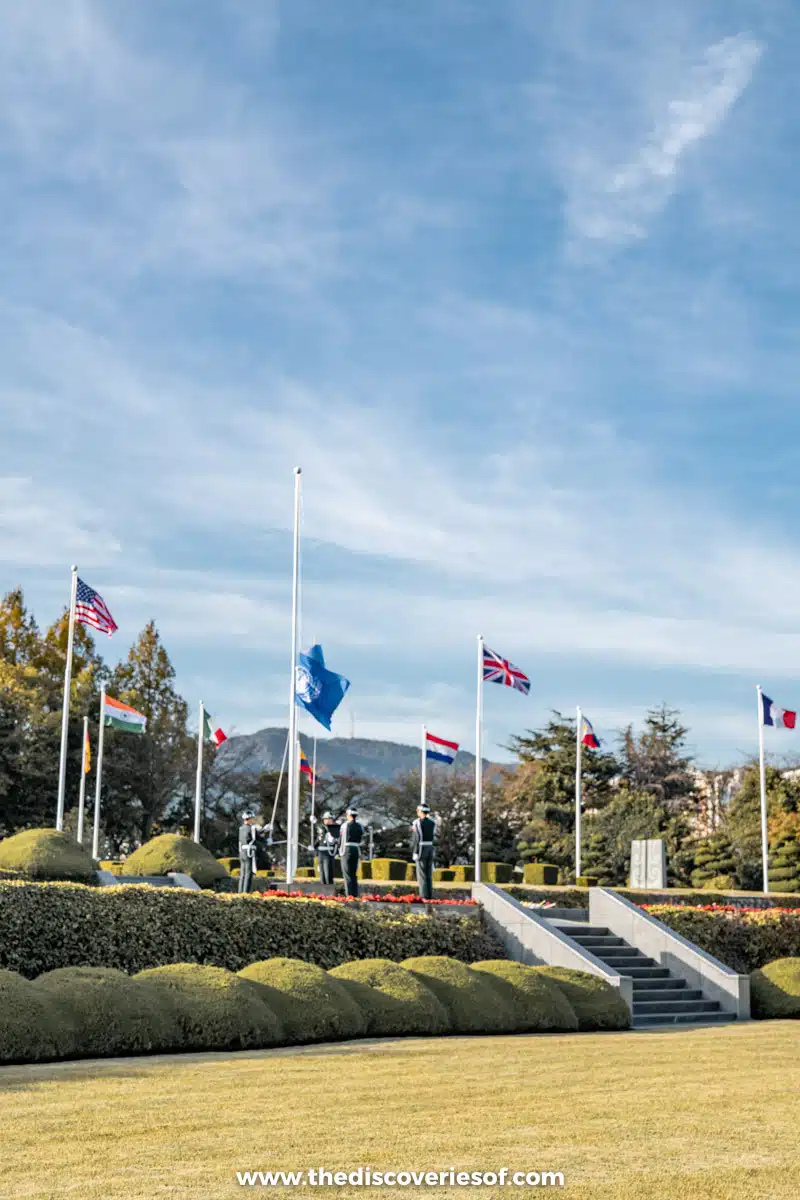
The Korean War lasted from 1950 to 1953, with over 2 million casualties. Of these, thousands were United Nations members and soldiers attempting to protect the peace agreement and freedom of South Korea, and over 2,000 are buried at UN Memorial Cemetery.
Touring the cemetery drives home how important the UN effort was (and still is) to the South Korean people. To say that I was moved by the flag-raising and lowering ceremonies and the educational video is an understatement. The grounds themselves feature the tombstones of soldiers, beautiful manicured hedges and trees, and the flags of the countries involved in the UN war effort.
It’s an absolute must-visit when you’re in Busan to learn more about the history and pay respects to the fallen soldiers who protected South Korea.
Look Down at the City and Sea from the Busan Air Cruise
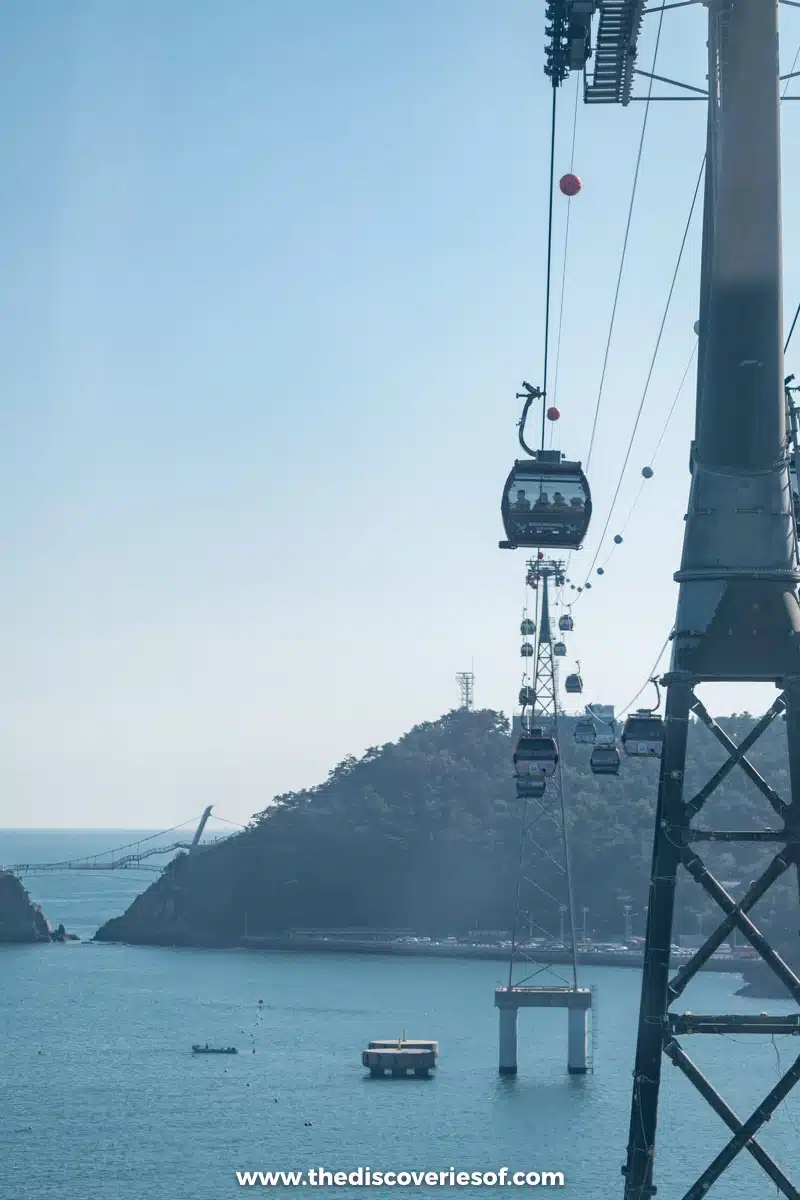
Busan Air Cruise (Songdo Marine Cable Car) is a recent project near the popular Songdo Beach area, which takes passengers up over the water, offering some of the prettiest views of the ocean and city in Busan.
The 1.62 km (1 mile) ride was once part of the city’s cable car transportation, but a 2017 effort to make Songdo a tourist attraction has quickly turned the previously utilitarian ride into one of the top Busan attractions.
The cable cars bring you from Songdo Bay Station to Songdo Sky Park, which is worth walking around, mostly for the epic city views. The park itself is rather strange, as I couldn’t quite understand why the growling gorillas were there in the first place.
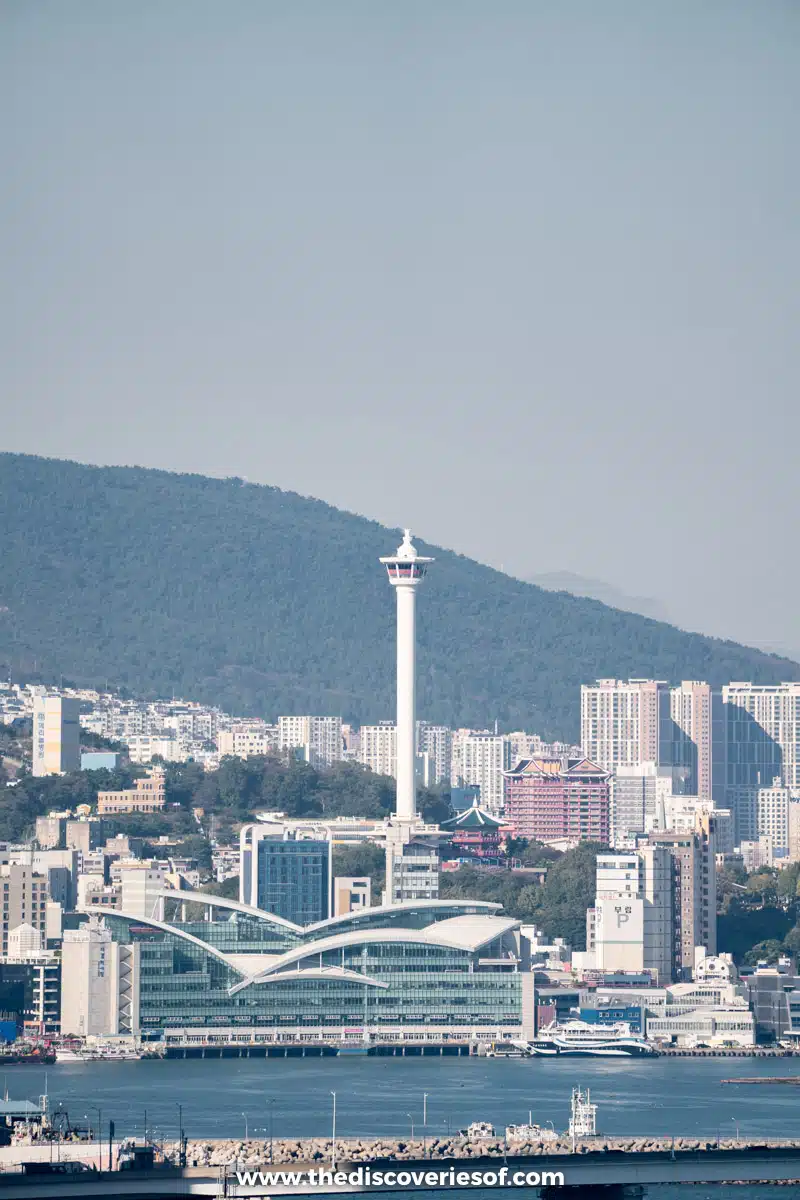
Take the journey round trip and splurge on a premium Crystal Cruise ticket; your investment pays off with insane views of the ocean and Songdo Cloud Trails from a glass floor underneath your seat.
Have Dinner at Korean Steak Grill 전설의 우대갈비 해운대직영점

Ok, so you’re probably aware that South Korea is a foodie’s dream destination, but care to know my favourite meal in the entire country? I thought so.
After recently visiting, I can honestly say that Korean Steak Grill 전설의 우대갈비 해운대직영점 serves the best Korean BBQ I’ve ever had.
Walk up to the laid-back eatery overlooking Haeundae Beach, and you might not expect much, but trust me when I tell you that the perfectly seared tender cuts of steak hand-carved at your table are mind-blowing. And as Korean BBQ goes, your meal is full of surprises, including delicious Jangajji (pickled veggies) that help cut through the fat and add some wonderful flavour to the experience.
It’s also a rare restaurant where the food is matched with an equally impressive view, as you’re perched 3 stories above Haeundae Beach from the cosy booths.
Prices are fair, the staff is friendly (and many speak English), and the festive atmosphere perfectly matches the nearby beach scene.
Explore Gamcheon Cultural Village
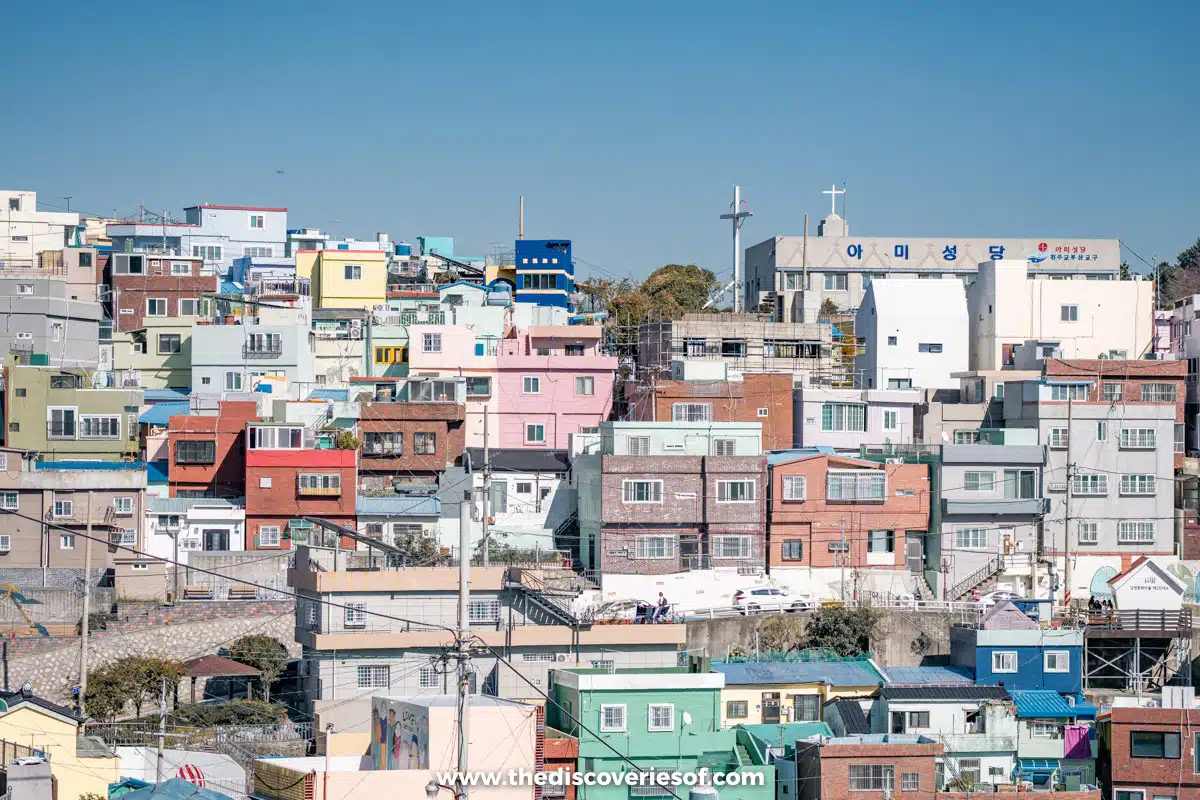
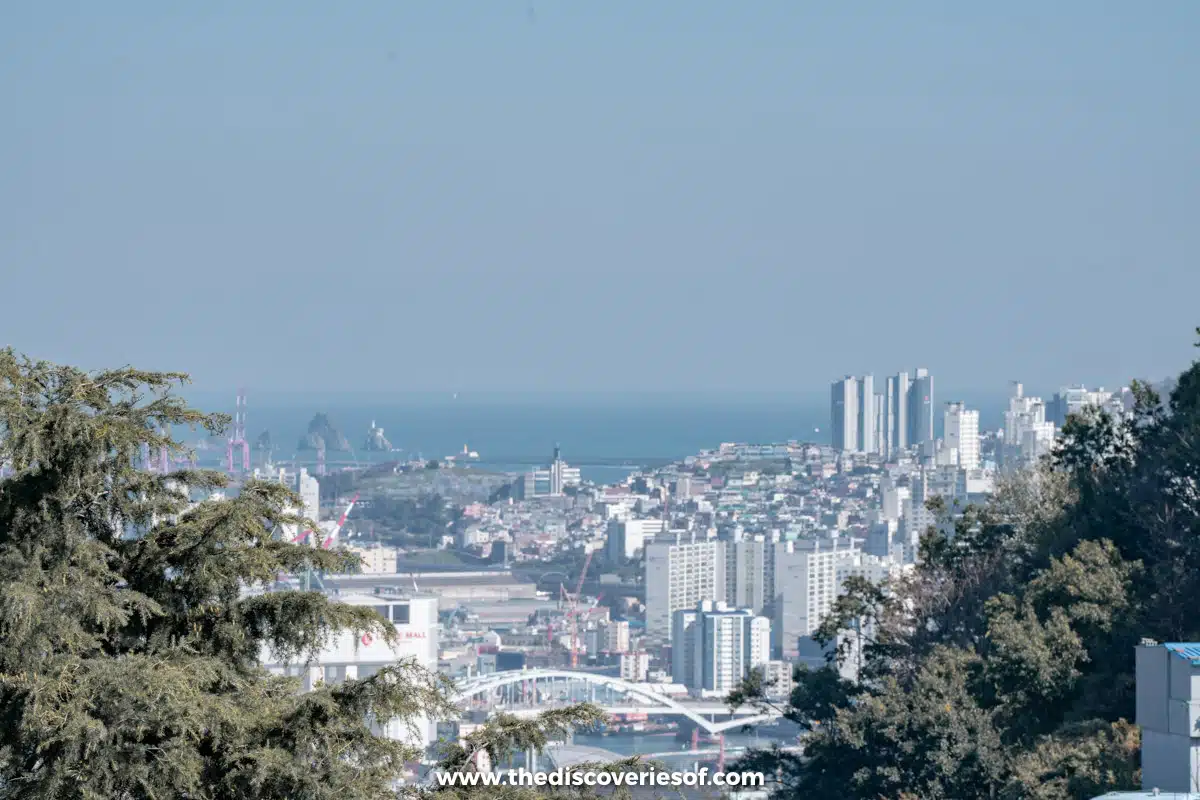
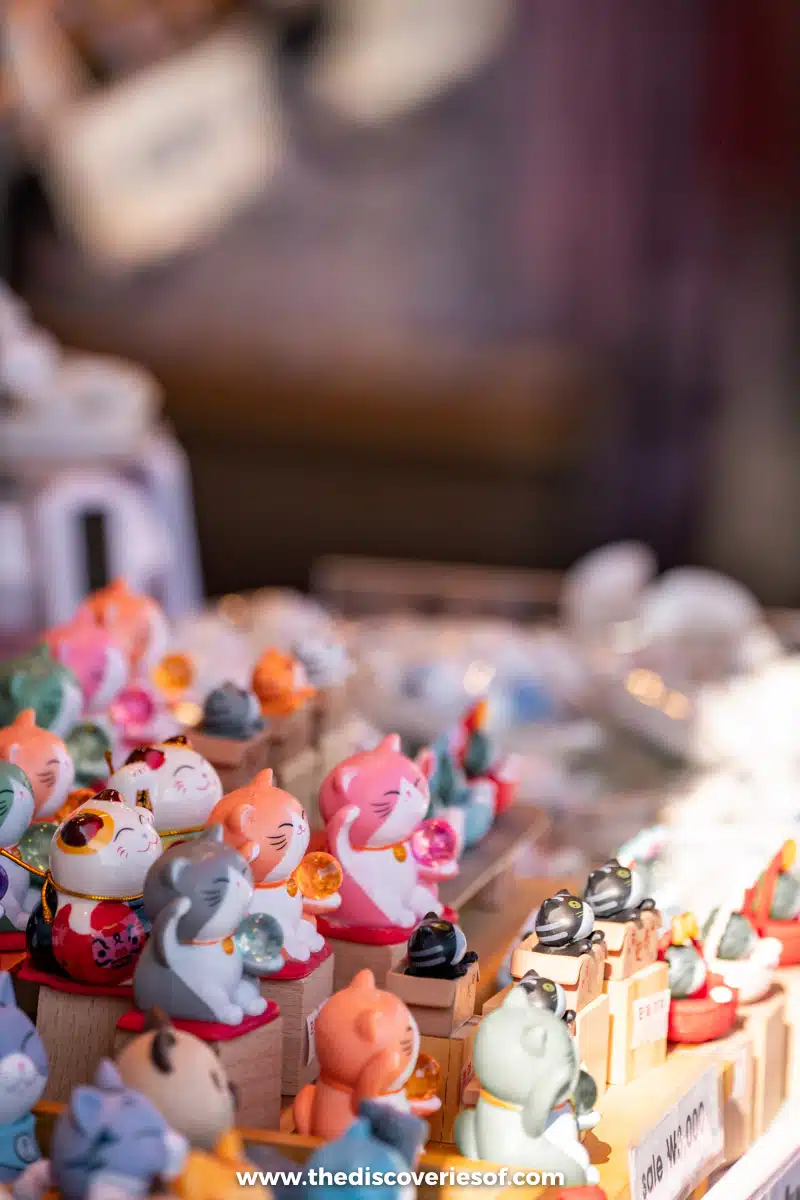
In the early to mid-20th century, Gamcheon Cultural Village sprouted up as the demand for housing increased in Busan. The lower-income neighbourhood featured houses built side by side on a hill above the bay below.
Over the years, the metal shacks became 2-story wooden homes in what was known then as Taeguk Village. But the homes and neighbourhood slowly fell into hard times over the decades.
Starting in 2009, the Ministry of Culture, Sports, and Tourism began an initiative to renovate the village by encouraging artists and Busan residents to help fix and decorate the houses. This is when the art installations and brightly coloured homes began to take shape and become what’s now one of the most popular tourist destinations in the city.
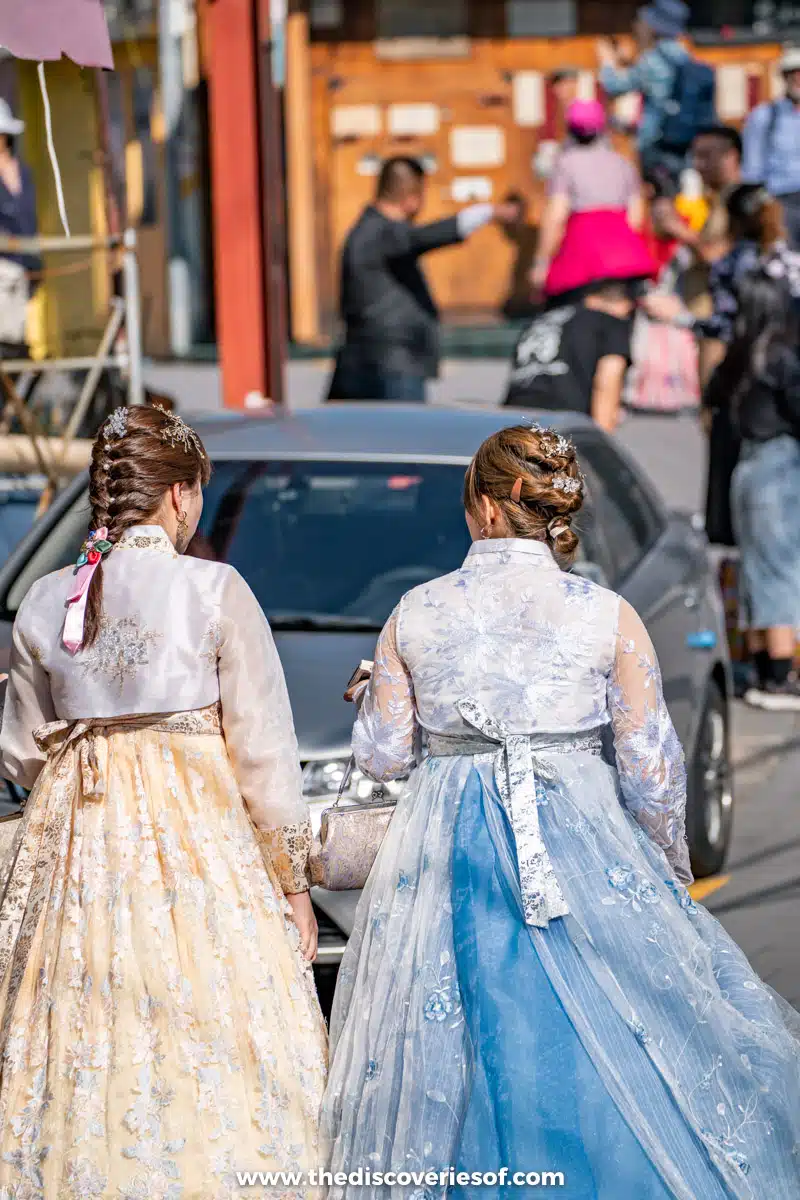
It’s no wonder it’s one of Busan’s most photographed spots – the colourful and quirky streets also boast great views out to Busan Bay. If you want a better view of the village itself, hike up to the Haneul Maru Observation Deck and be sure to take plenty of pictures of the pastel homes.
Top Tip
Speaking of photos, are you looking for the perfect reels for the ‘Gram? Rent a Hanbok from Hanbokithouse and stroll the streets with a friend to photograph the storefronts and murals in a traditional dress.
Visit Haedong Yonggungsa Temple
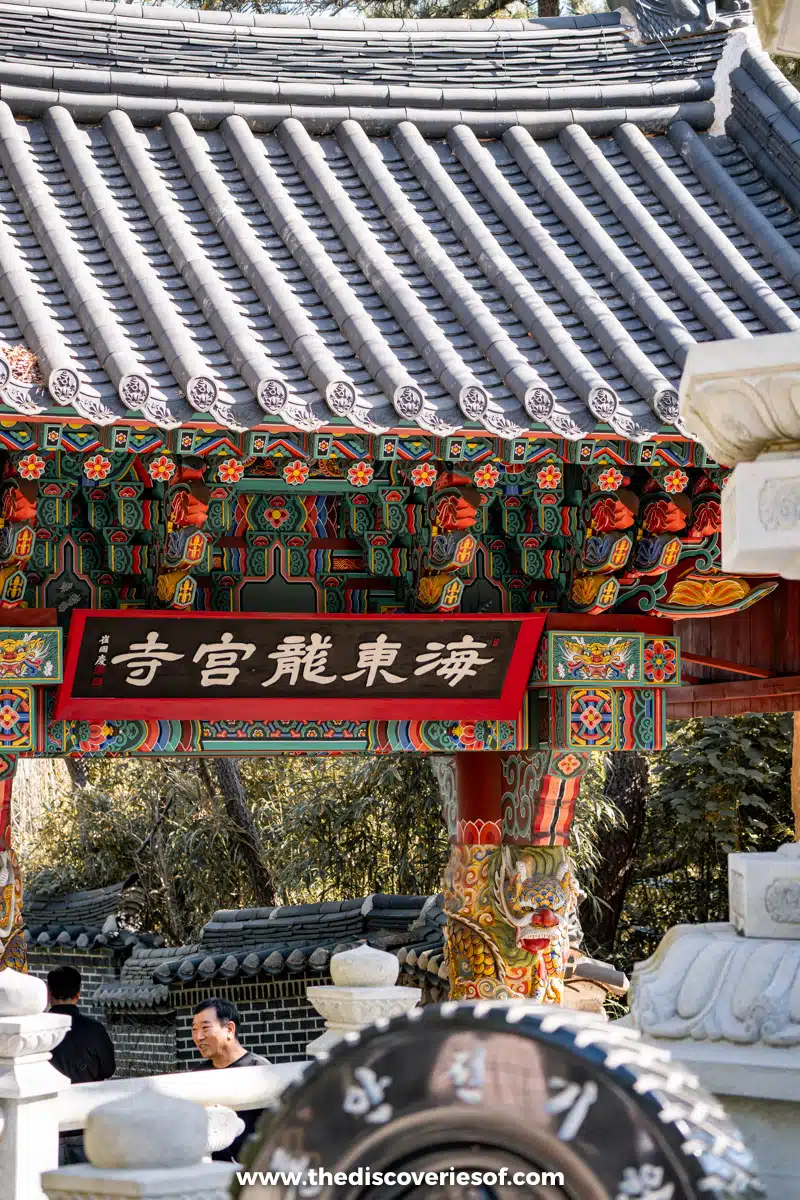
Haedong Yonggungsa Temple is the most scenic in Busan (if not all of South Korea), perched high on a rocky coastal cliff in Northern Busan.
The temple dates as far back as 1376 (though historians debate this) but was destroyed in 1592 when Japanese troops invaded South Korea. It stands today thanks to renovation efforts in the 1970s, and it feels much older than it is.
You’ll notice immediately when you walk up just how beautiful the setting is, from the coastal views above the complex to the large golden dragons that greet you at the gate.
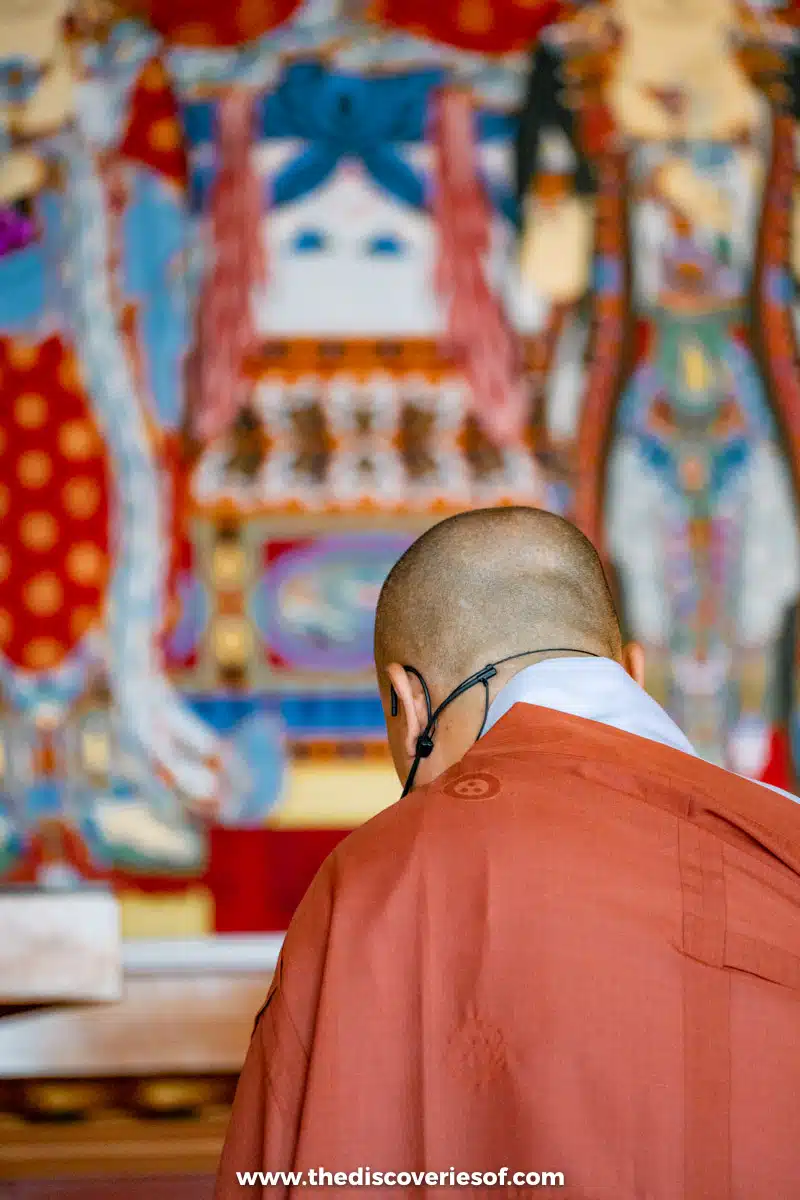
Daeungjeon Main Hall is the first building you’ll see, and it’s beautiful inside and out. The building features Joseon-era architecture with gorgeous tiles and a roof that curls towards the skies like traditional Hanok homes.
You’ll also notice a few Buddhist statues, like the iconic golden laughing Buddha – take a photo with the statue for good luck.
Save some energy to walk down (and back up) the 108 stairs, which offer up some of the most scenic views of the temple and ocean below.
Getting There
From Haeundae Station (exit 7), you can take 181 directly to the temple, which takes around 45 minutes.
Shopping and Sightseeing at Gukje Market
Gukje Market is a massive street market that’s been a hub for everyday essentials for Busan locals since 1945.
The market really became popular when the Korean War turned Busan into the vibrant second city that it is today. It’s a lively place with a friendly, bustling vibe, and you can find lots of great deals if you look carefully.
You’ll still see thousands of locals shopping at the outdoor marketplace, where you can find anything from keepsakes to everyday items for your household. Some things to look for when you visit include artwork, clothing, and miniature gifts that are perfect for bringing back to your jealous friends.
When should you go? The market is open every day from 9 am to 7 pm, but I think visiting in the morning is a fun time to see the market at its liveliest time.
Stroll Along Songdo Cloud Trails
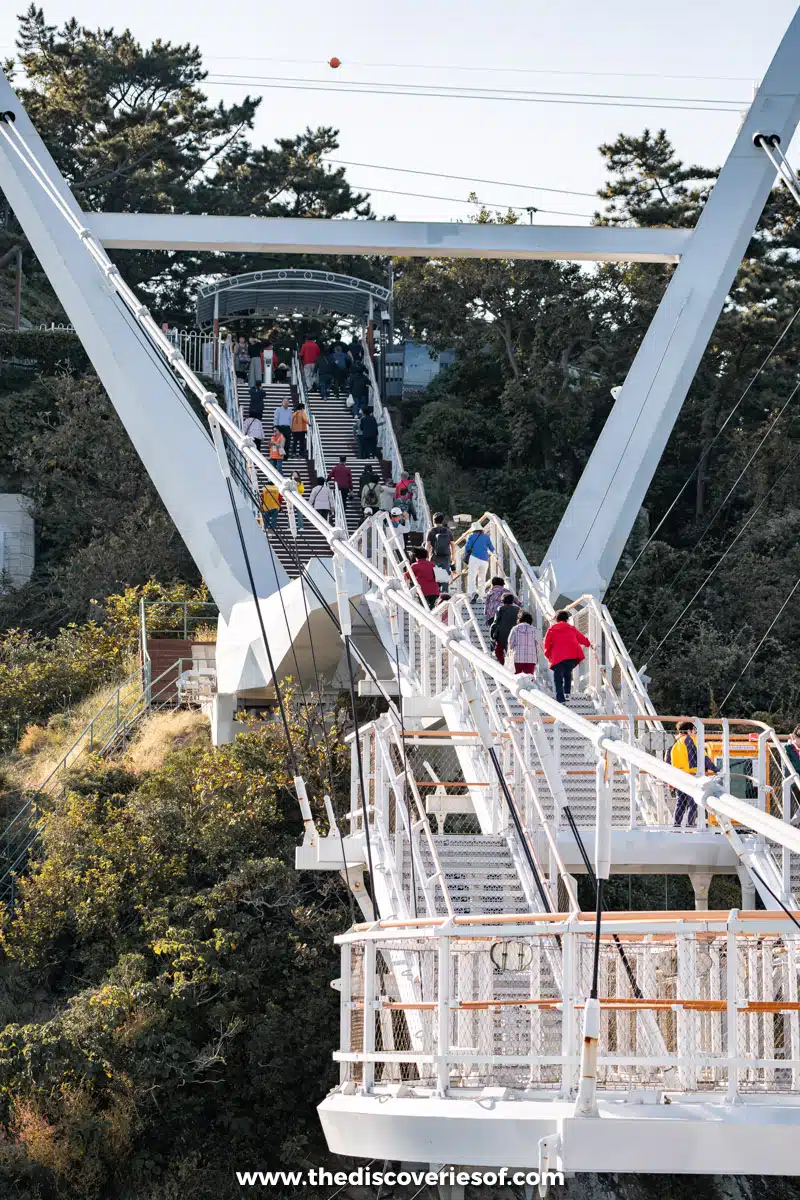
There’s nothing quite like a good urban hike along the coast, and Songdo Cloud Trails takes it a step further. The 365-metre trail is elevated above Songdo Bay, giving you excellent views of the coast, the city, and the Busan Air Cruise above.
It’s a beautiful way to see the metropolis and Busan Bay, but there are some art installations and features to keep track of, too.
First of all, there’s a glass floor on sections of the boardwalk, which is a cool way to see the tides rolling in under your feet.
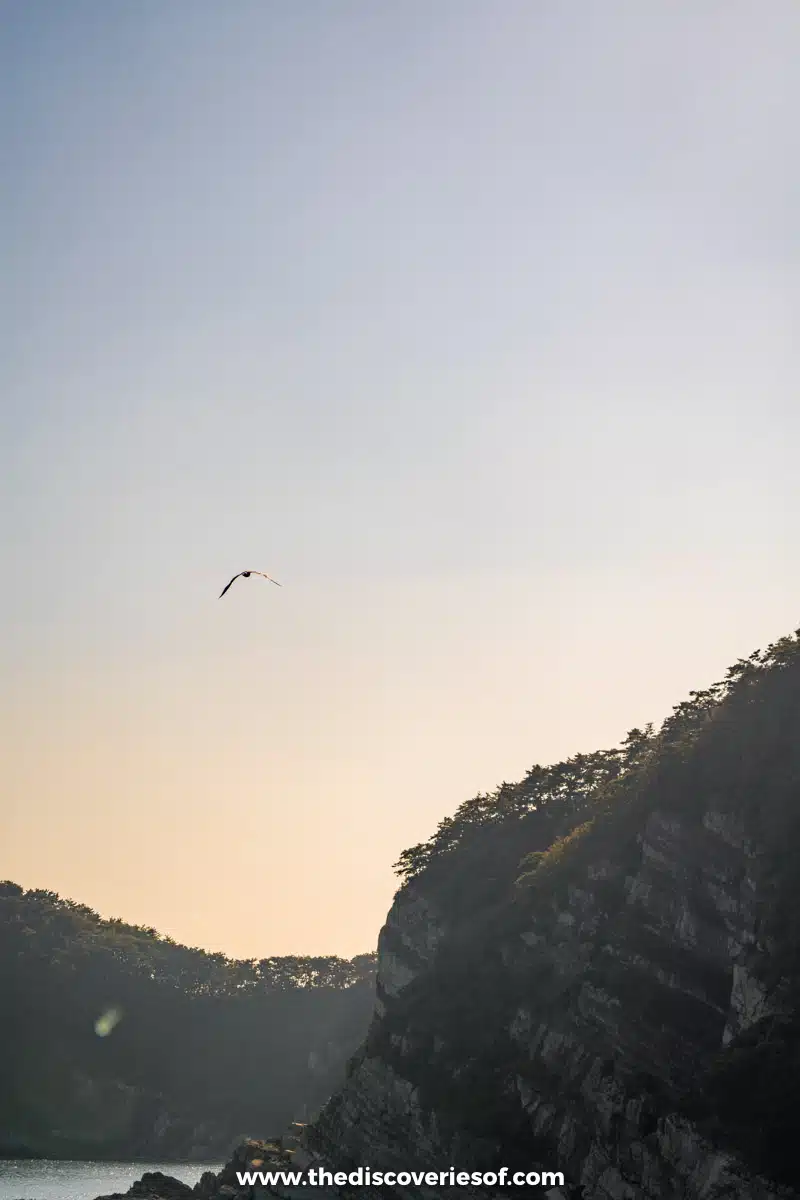
Once you get to Turtle Island (yes, the rocky isle does resemble everyone’s favourite shelled reptile), take note of the fisherman and mermaid statues. There’s a legend that they were lovers and that her father turned the fisherman into Turtle Island so they could be together forever.
The Songdo Cloud Trails are open 365 days a year from 6 am to 11 pm. But if you want to see the low-hanging clouds that gave the trail its name, arrive early.
See the City Lights on the Diamond Bay Yacht
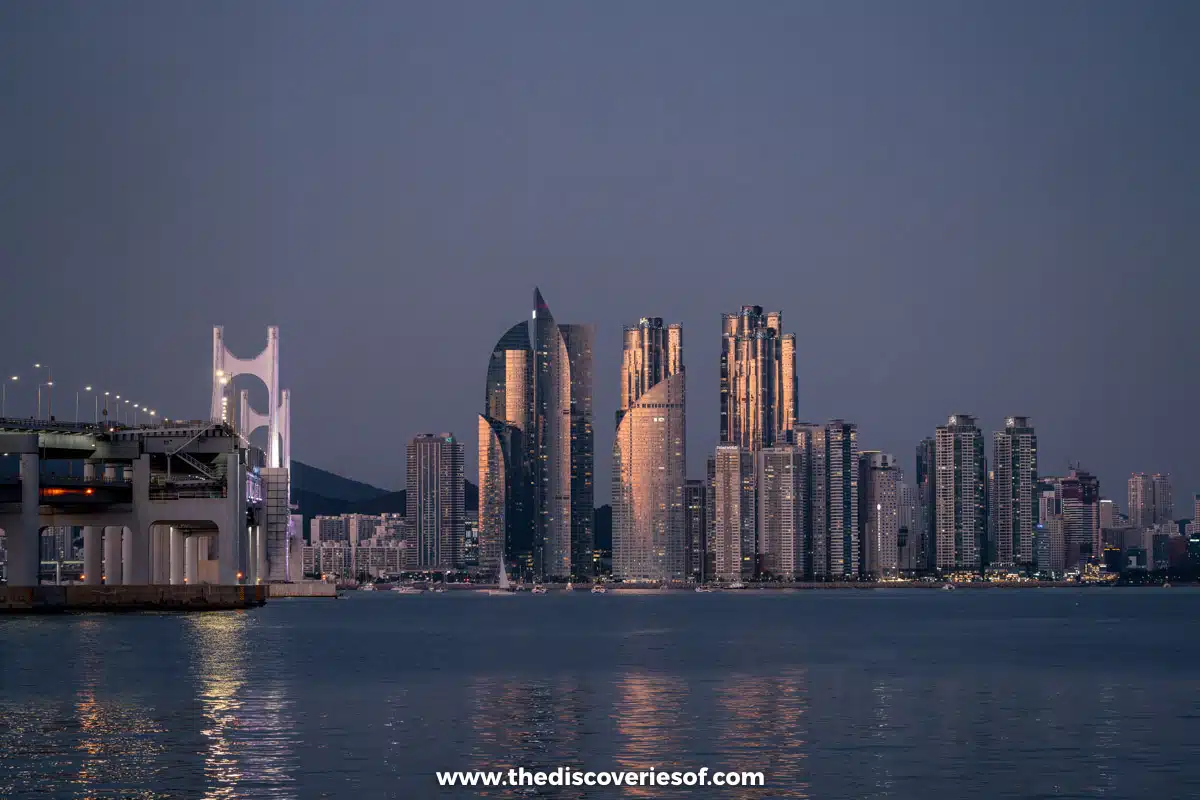
Because of its coastal location, there are some epic ways to catch the best views of Busan. But if you have the slightest sea legs, you’ll absolutely love your time on the Diamond Bay Yacht.
The 72-foot catamaran has been sailing the Sea of Japan off the coast of Busan since 2014. For a very reasonable price of around £18 ($23), you can zip along the harbour and see some of the city’s most famous landmarks (including Haeundae Beach and Gwangan Bridge) from out on the water.
You can choose one of two popular routes for your cruise on the Diamond Bay Yacht. These include the Oyrukdo and Haeundae Routes. Both are about 45 minutes long and allow you to photograph the port city while riding on a catamaran.
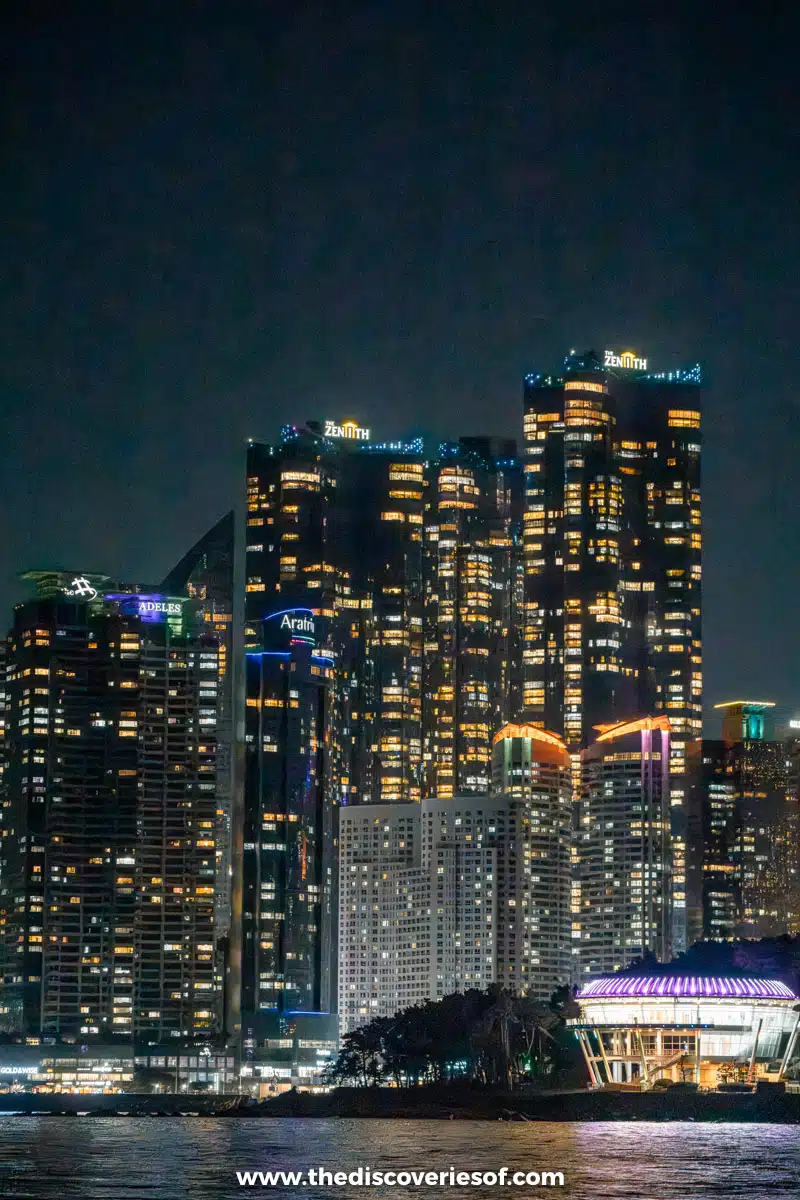
So, which should you choose? I think the Haeundae Route is the way to go because you set sail around sundown. This allows you to take in the bright city lights and the bridge light show at 8 pm and 10 pm, which is worth staying up a little later to see.
Top Tip
Diamond Bay does cancel routes due to bad weather or lack of demand. Call +82 10-9260-3332 or stop by 101 Bunpo-ro, Yongho-dong, Nam-gu, Busan, before you take sail for more information.
Explore the Colourful Huinnyeoul Culture Village
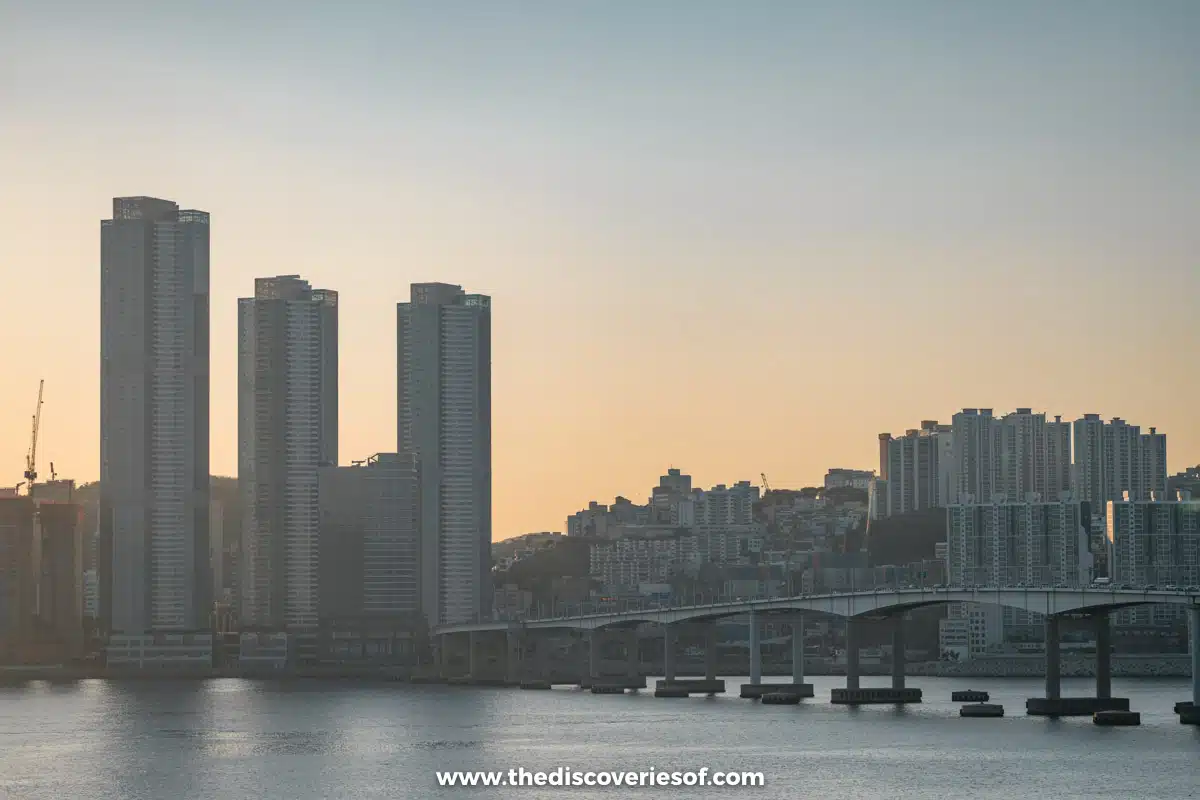
Huinnyeoul Culture Village is part of the Yeongdo District and an area that’s increasingly known as the “Santorini of Busan.” Why, you might ask? Hike around the colourful houses and scenic staircases overlooking Busan and its coastline, and you’ll quickly understand the resemblance to the famous Greek Island.
Once you’re there, I recommend simply getting lost in the winding streets. Really. It’s a very walkable area (if you’re okay with hills) and home to some of the coolest hidden gems in South Korea.
On my last visit, I was charmed by the Huinnyeoul Trail, which features beautiful murals along the houses, cafes, and even the trail itself. This pathway leads you to the Huinnyeol Coastal Tunnel, which boasts some of the most beautiful views of the harbour and Namhangdaegyo Bridge.
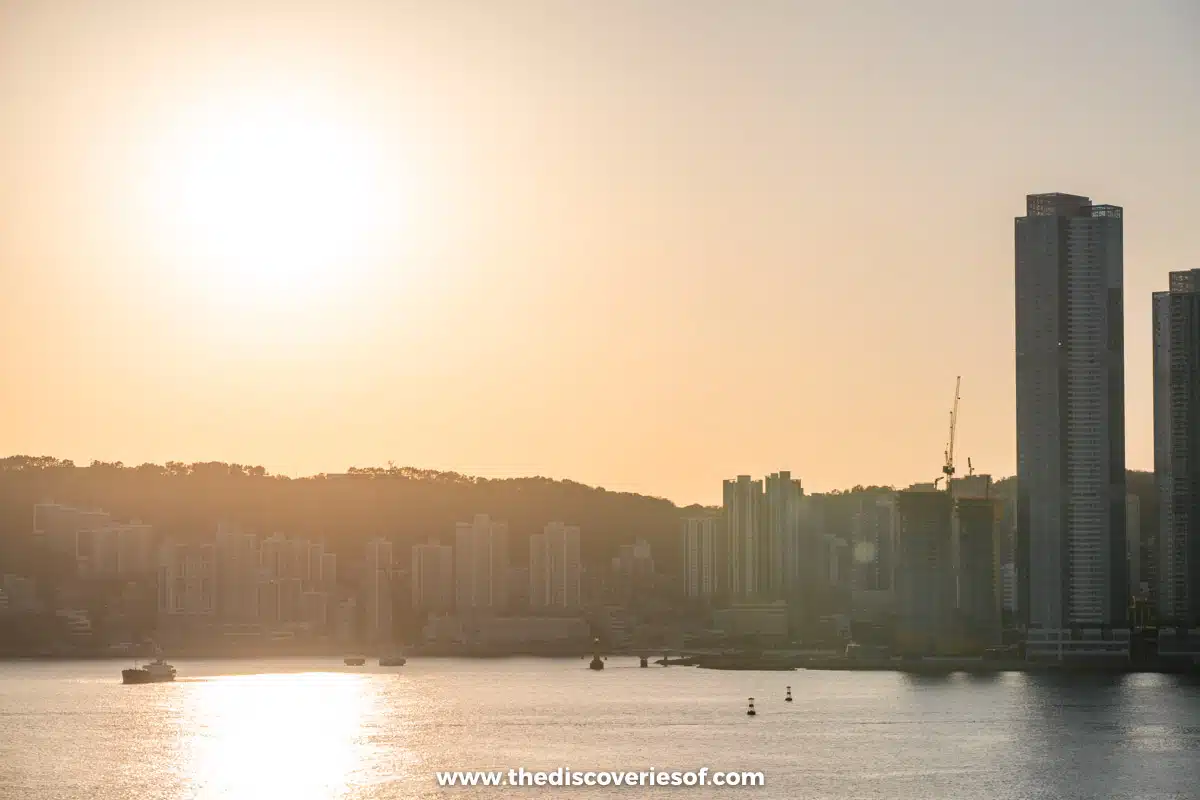
There are also lots of cool shops and cafes to explore along the narrow streets, like the charming Sosohan Hinyeoul souvenir store. Feeling hungry? Stop by Huinnyeoul Jeombbang for an easy snack of instant noodles (ramyun) and an iced coffee with one of the best views in the village.
Getting There
You can take one of several buses from Nampo Station (508 is one of the most popular) to Huinnyeoul Culture Village in about 20 minutes.
Paddle Out From Gwangalli Beach
There are some excellent beaches in Busan, but Gwangalli Beach is probably my favourite.
Don’t get me wrong, the festive atmosphere at Haeundae Beach and the view from and above Songdu Beach are both great, but this stretch of white sands is still flying under the radar of too many tourists and locals.
Spend an afternoon (or evening) on the coast overlooking the 500 metre (1640-foot) Gwangan Bridge over the Sea of Japan, and you’ll see why I love it. Looking to take it to the next level? Hire a stand-up paddle board from the vendors at the beach.
Coasting out into the cove was a bit more thrilling than I imagined, but I enjoyed every rocky minute of it. You might fall in once or twice, but the views of the bridge, city, and sandy shores are worth the unexpected swim.
You can rent a paddleboard from the beach for around £20 ($25) for around 3 hours, which is a bargain.
Top Tip
Rent the paddleboard later in the day, and you’ll enjoy a sunset paddle where the bright blue, red, and purple lights on the bridge add dramatic effect to your nautical adventure.
Views From BUSAN X the SKY
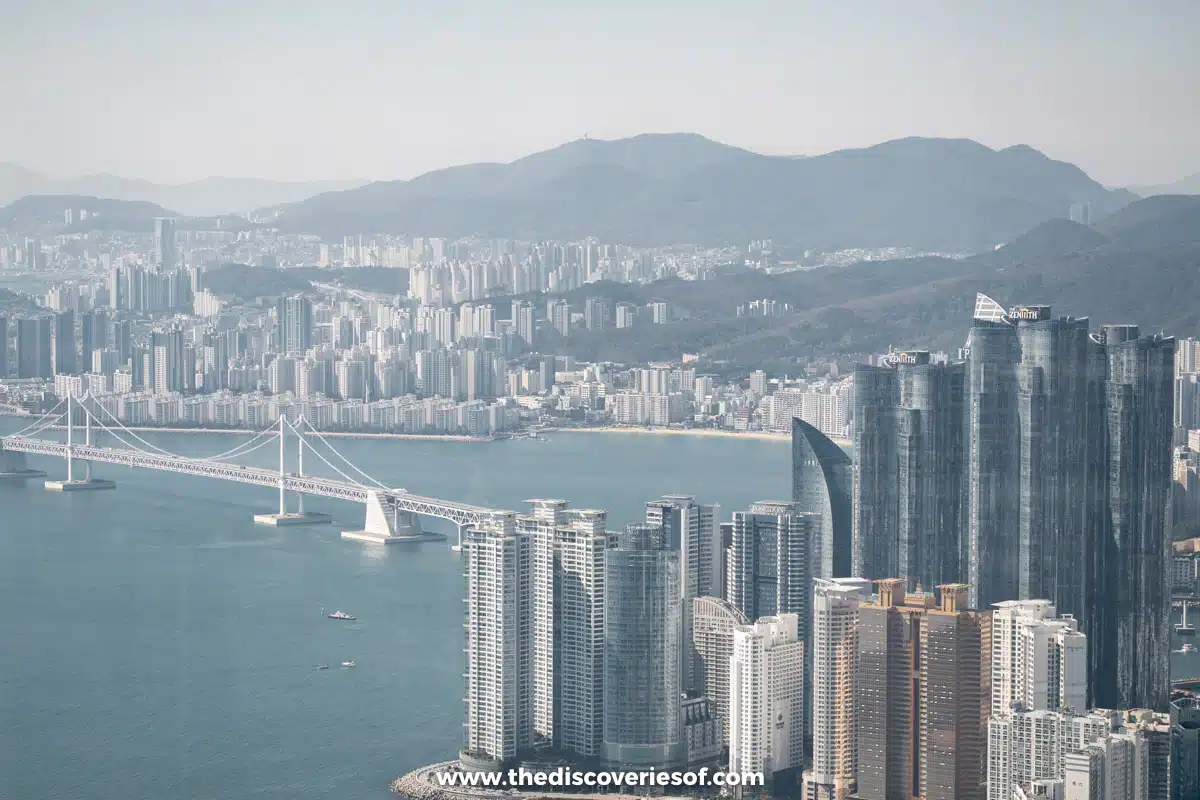
South Korea is home to nearly 300 skyscrapers, with an impressive 62 in Busan alone. The greatest of them all is Haeundae LCT Landmark Tower, which is home to the BUSAN X the Sky observatory.
I know heading to the top of the tallest building isn’t on everyone’s to-do list when visiting a new city. Trust me, this one definitely should be.
The nearly 412-metre summit up the lift to the 100th floor (yes, really) rewards you with spectacular panoramic views from the top, and there’s also a cool video that shows you climbing (and descending) in an air balloon on a video screen inside.
There are actually 3 levels you can access, each with its own perks. In addition to the stunning views of the nearby coastline from Haeundae Beach to Dongbaekseom Island from floor 100, there’s a fine dining restaurant (Sky 99) and a souvenir shop on level 98.
Although the “world’s tallest Starbucks” is on level 99, I recommend trying Blackup Coffee on floor 98, which is a local chain known for its iced coffees.
Top Tip
Don’t miss a chance to cross Shocking Bridge, a glass-bottom walkway with absolutely amazing views of Haeundae Beach 100 floors below you.
Spend an Afternoon at Haeundae Blue Line Park
Haeundae Blue Line Park is one of the newest additions to the constantly evolving city of Busan, and it’s taken the social media world by storm. What was once a dusty old elevated train track is now one of the most popular tourist attractions in Busan.
Similar to the Highline in New York City, the former railway is now a great place to take a stroll and admire the city views. However, what makes it a lot different is that you’ll ride along this 4.8 km (3-mile) route in the brightly coloured Sky Capsules (cute little aerial cars that allow you to pootle your way over Busan and its famous coastline).
It takes about 30 minutes to complete the whole track, which provides beautiful views of Haeundae Beach and Busan Bay from the adorable cars slowly cruising along up on the 10-metre (33-foot) high track.
How can you reserved a seat? Book a 2-seat car for around £21 ($27), which gets you from the Mipo Station to Cheongsapo Station on a scenic route with pine trees and ocean views for days.
Take a Footbath in Natural Hot Springs
Locals taking in the healing properties of natural hot springs around Busan is nothing new. In fact, residents have enjoyed the warm, therapeutic waters for centuries, dating all the way back to the Silla era in 57 BC.
When you exit Oncheonjang Station, you may notice statues of an older woman and a bird, both painted gold. This is a tribute to the hot spring baths, as an old legend tells a tale of a woman who saw a crane heal its injured leg in the water and followed in their footsteps with great success.
Dongnae Hot Springs near the Oncheonjang Station has a long tradition of natural hot springs, and it is home to an outdoor foot bath, which is open to the public from 10 am to 5 pm (except on Wednesdays and Fridays) and reaches as high as 63°C (145°F).
Locals spend 20-30 minutes relieving their feet, as many believe the mineral-rich water cures inflammatory conditions.
Top Tip
If you’d rather not travel as far from the hotel zone, Haeundae Hot Spring Footbath is another free option near Haeundae Beach, where you can relax and soak your feet in the majestic waters.
Hike to Geumjeongsanseong Fortress
Hiking is a very popular pastime in South Korea, and Busan’s steep mountains and coastal views make it a perfect place to lace up your boots and get out on the trails.
But this 7.6-mile point-to-point trail to Geumjeongsanseong Fortress is one you won’t want to miss on your trip to the second city, as it’s not only scenic but also offers a history lesson about one of the most overlooked Busan attractions.
Japan attacked South Korea more than once in the 16th and 17th centuries, and King Sukjong built the Geumjeongsanseong Fortress in 1703 to protect the Joseon Dynasty rule in South Korea. Hiking up Mount Geumjeongsan, you’ll see some of South Korea’s most historic architecture along the stone walls and imposing gates of the fortress, many of which are restored.
If you enter inside the North Gate, you’ll discover Beomeosa Temple, which dates back to the 7th Century and is home to some amazing artefacts like the large stone lanterns just before Daeungjeon Hall, which dates back to Silla rule.
The hike itself is no walk in the park. There is a challenging 840 metres (2,760 feet) of elevation change, and conditions can be even more difficult with wind and rain. Still, it’s one of the most rewarding hikes around and a must when you’re in Busan.
Try the Famous Poisonous Fish
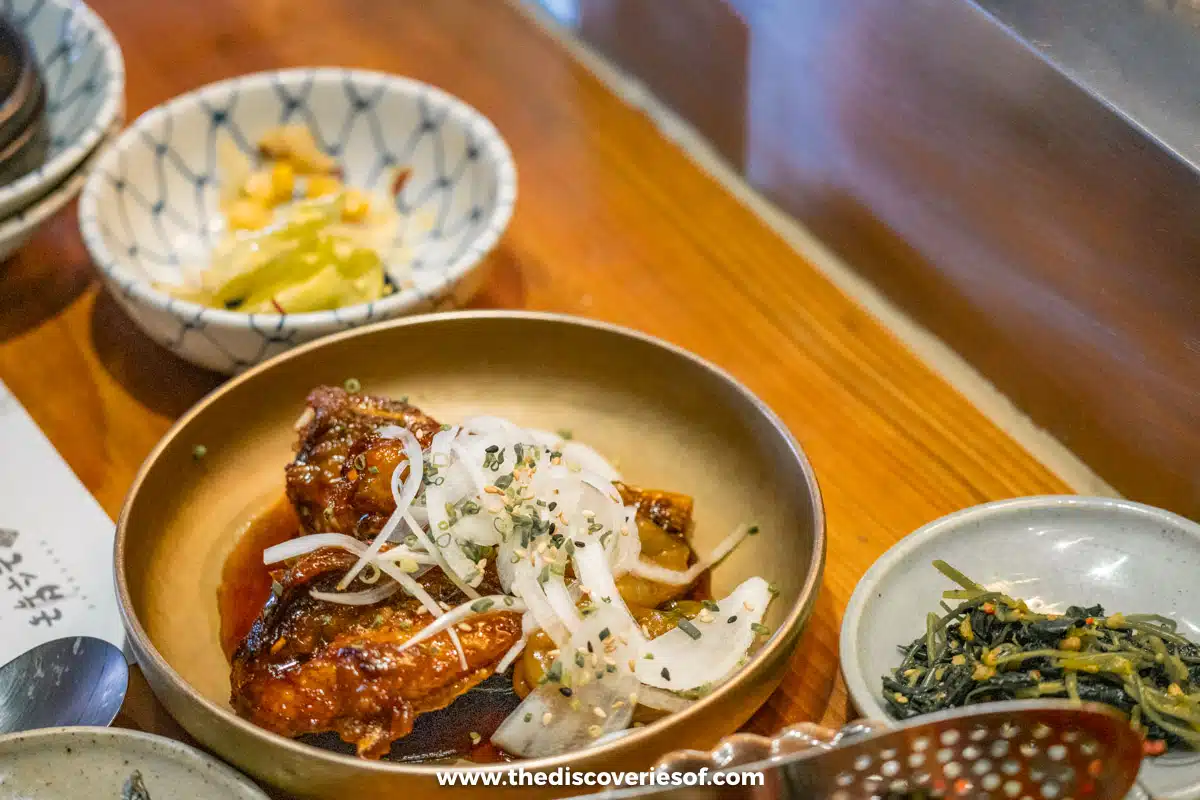
Ok, so this one might not be for everyone. But I was floored when I heard I could finally try the fish that’s so poisonous you’ll quite literally keel over if you eat an incorrectly prepared plate. Sign me up.
Now, in all seriousness, the dish is made by chefs who aren’t only experts at cooking but are also fully licensed to serve the famous blowfish.
So where should you try it? Head to Geumsubokguk, Haeundae Head Store, which has served up the dangerous delicacy for nearly 50 years.
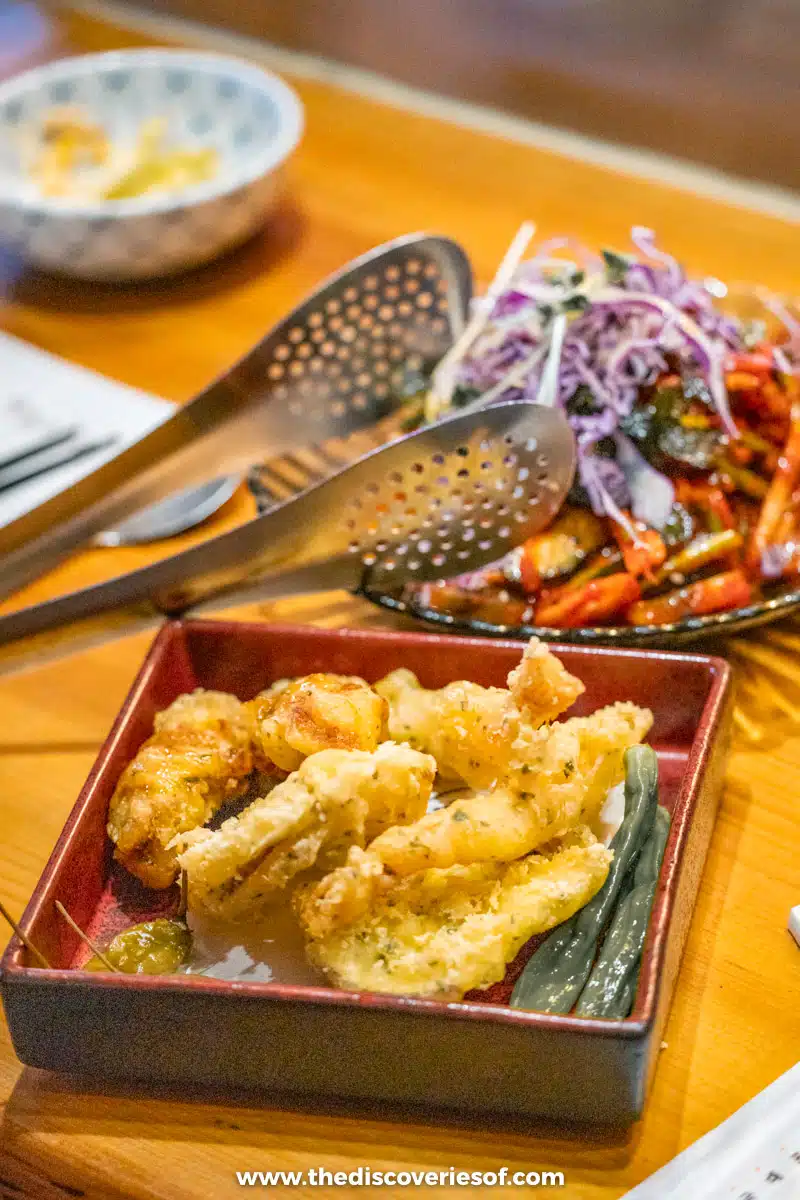
I tried it two different ways – in a clear broth (this was OK, but not my favourite) and in teriyaki sauce. The latter was brilliant, and the meaty flavour of the fish stood up really well to the teriyaki marinade for an exciting dining experience.
Getting There
From Haeundae Traditional Market, you can take the 115-1 bus line to Haeundae Hot Springs Sageori and walk South for just a few minutes.
Practical Tips for Your Busan Trip
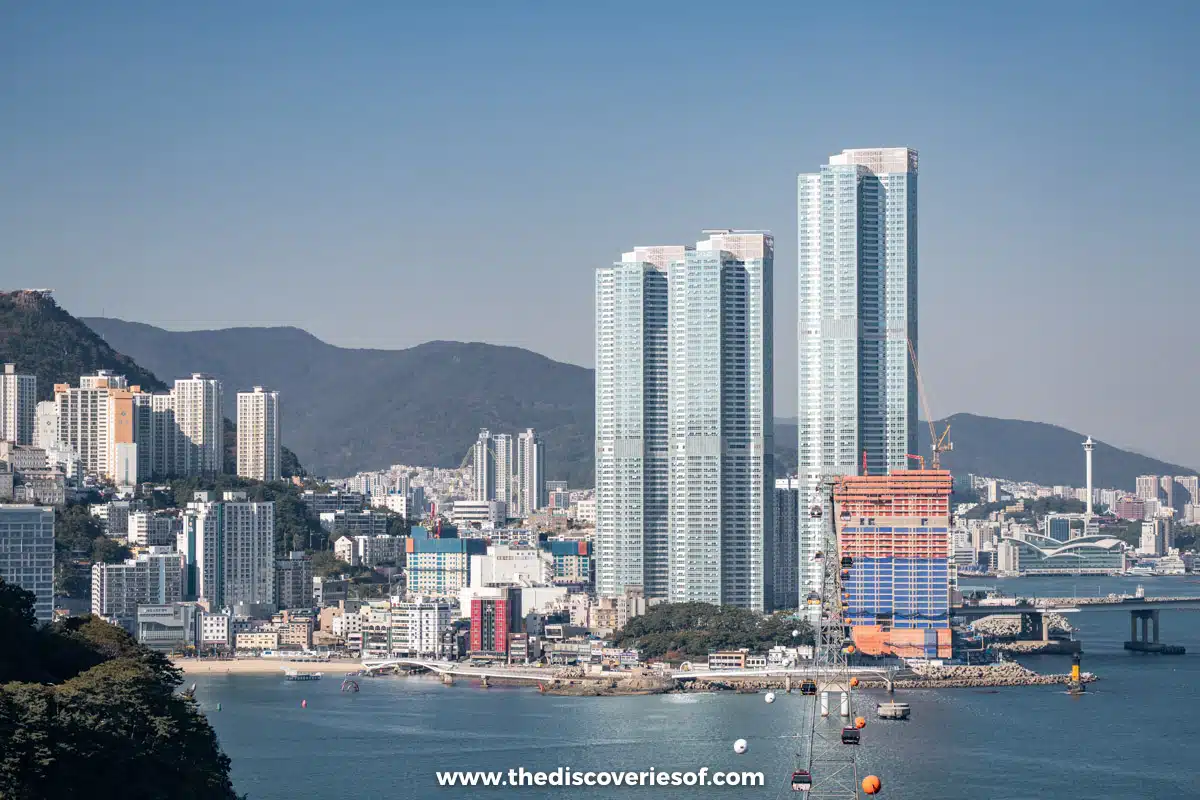
Top Tips for Your Visit
- If you’re visiting from Seoul, take the KTX train, which gets you from door to door in under 3 hours and is a scenic and comfortable ride.
- The city has an excellent subway and bus system, which you can use to explore most destinations once you’re in Busan.
- If you book a rideshare, use KakaoTaxi, as Busan doesn’t have Uber.
- Bring sunscreen and swimwear if you visit in the summer. Busan is hot and sunny from June to September.
How Long to Visit in Busan?
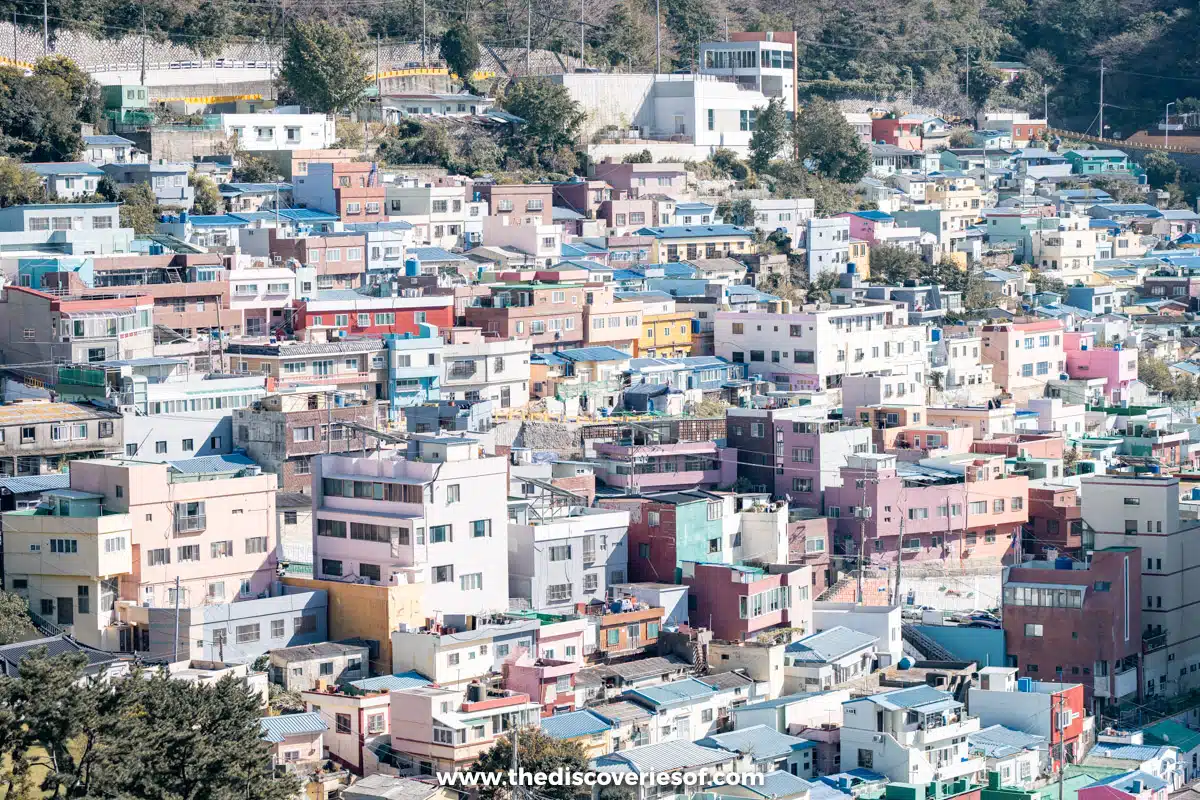
Plan on spending 2-3 days in Busan. If you travel in the summer, I’d recommend an extra day to spend some time on the water.
Best Time to Visit
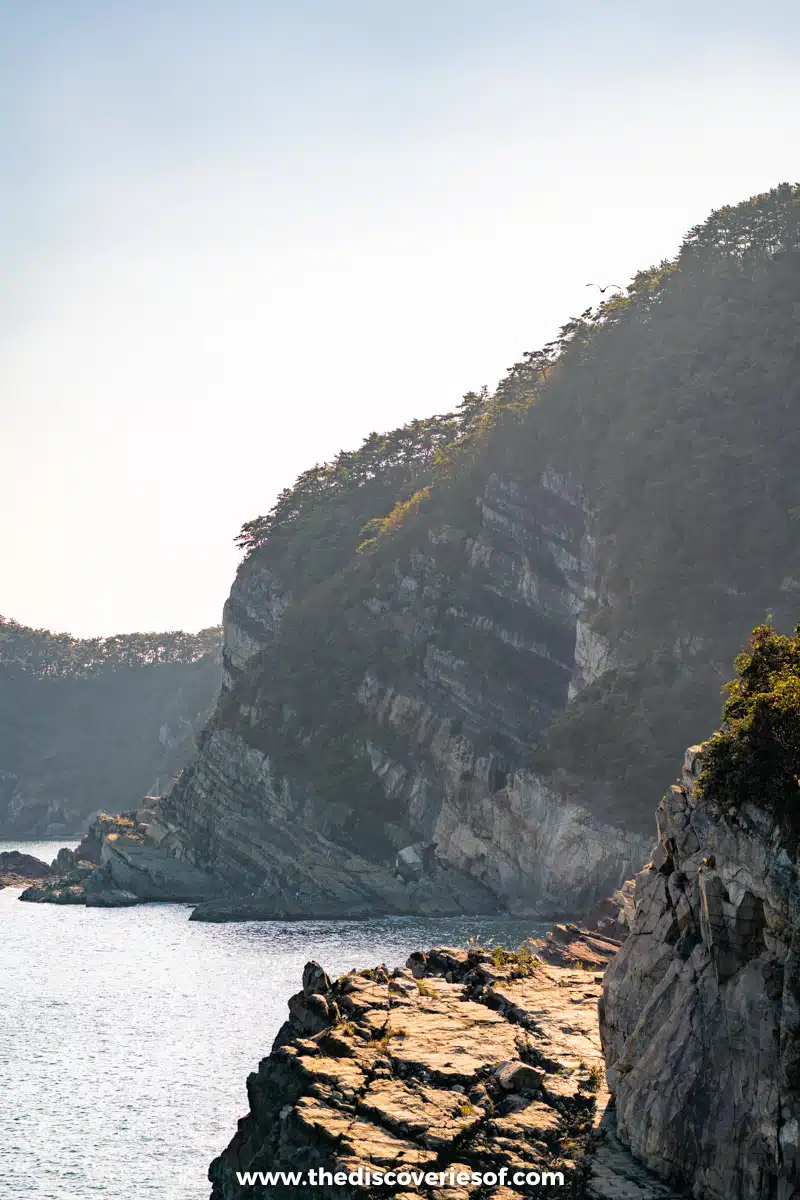
Summer is the best time of year to visit Busan. The weather is great, and you can really take advantage of its location on the sea.
Where Should I Stay in Busan?
Centum Premier Hotel (Mid-Range)
Centum Permier Hotel is centrally located near the subway and has small but classy rooms at competitive rates.
Check Prices and Availability for Centum Premier Hotel on Booking.com
Grand Josun Busan (Luxury)
Grand Josun Busan is a 5-star hotel just a short walk from Haeundae Beach. A rooftop pool, breakfast buffet, and beautiful views from the rooms and suites are just a few of the perks of this luxury accommodation.
Check Prices and Availability for Grand Josun Busan on Booking.com
Recommended Tours
Things to Do in Busan: Map
Explore More South Korea Guides
- Things to do in South Korea
- The Ultimate South Korea Itinerary
- Where to Stay in Busan
- 3 Days in Busan: A Step-by-Step Itinerary
Love This? Save and Share on Pinterest
